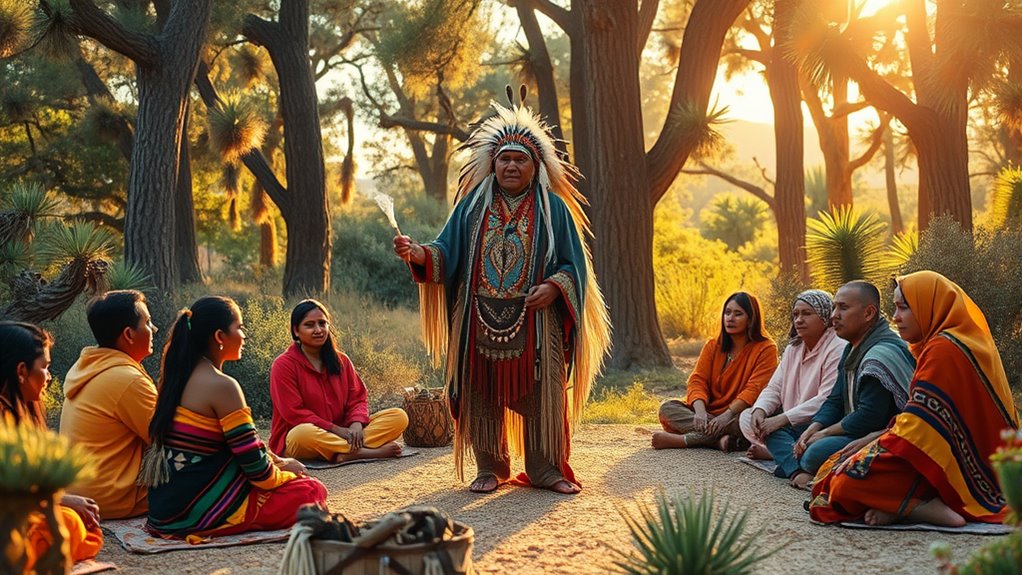Indigenous healing rituals emphasize balancing the mind, body, and spirit through ancient traditions rooted in harmony with nature and spiritual guidance. You’ll learn about ceremonies led by shamans that involve singing, drumming, and storytelling to invoke spirits and promote healing. Herbal medicines crafted from local plants are also key, often used alongside rituals to restore health and spiritual well-being. Exploring these practices reveals a holistic approach to wellness that continues to influence modern understanding.
Key Takeaways
- Indigenous healing rituals emphasize harmony among mind, body, and spirit through ceremonies involving singing, drumming, and spiritual invocation.
- Shamans serve as mediators, guiding spiritual connections and facilitating healing through sacred ceremonies and storytelling.
- Herbal medicines, crafted from local plants, are integrated into rituals to promote physical and emotional well-being holistically.
- Natural elements like smoke and sacred objects create a spiritual space, reinforcing the interconnectedness of nature and health.
- These traditions view health as spiritual harmony, using rituals to realign energies and restore balance within the community.

Indigenous healing rituals are powerful practices rooted in centuries-old traditions that aim to restore balance between mind, body, and spirit. When you participate in these rituals, you’re engaging with a rich cultural tapestry that emphasizes harmony with nature and spiritual guidance. Central to many indigenous practices are shamanic ceremonies, which serve as sacred gatherings where shamans act as mediators between the physical world and spiritual domains. These ceremonies often involve singing, drumming, and chanting to invoke spirits, seek guidance, and facilitate healing. As a participant, you might experience these rituals as deeply transformative, helping you connect with your inner self and the natural world around you.
Herbal medicine plays a vital role in indigenous healing as well. You’re likely to find that traditional herbal remedies are crafted from locally sourced plants known for their healing properties. Shamans or community healers carefully prepare these medicines, believing they contain spiritual energy that can promote physical health and emotional well-being. When you use herbal medicine in these traditions, you’re not just taking a remedy; you’re participating in a holistic process that considers the spiritual significance of the plants. This approach emphasizes the interconnectedness of all living things, encouraging respect for nature and its gifts. It’s common to see herbal infusions, poultices, or teas used during healing rituals, each tailored to address specific ailments or spiritual imbalances. Moreover, these practices often incorporate vibrational energy techniques, aligning your spiritual and physical health with natural forces.
Attending a shamanic ceremony or using herbal medicine can be an eye-opening experience, offering insights into indigenous worldviews that see health as more than just the absence of illness. You might witness how shamans incorporate elements like smoke, sacred objects, and natural elements to create a sacred space for healing. These rituals often involve storytelling and prayers, reinforcing cultural values and spiritual beliefs. Many indigenous healers believe that illnesses stem from spiritual disharmony, and their ceremonies aim to realign your spiritual energy to restore health.
Frequently Asked Questions
How Do Indigenous Healing Practices Differ Across Tribes?
You’ll notice that indigenous healing practices differ across tribes due to cultural variations and ritual adaptations. Each tribe’s history, environment, and spiritual beliefs shape their healing methods. For example, some emphasize ceremony and prayer, while others focus on herbal medicines or dance. These differences reflect their unique traditions, ensuring that each community preserves its identity through specific rituals tailored to their cultural values and needs.
Can Non-Indigenous People Participate in These Rituals?
You can participate in indigenous healing rituals, but it is crucial to do so with respectful participation and awareness of cultural appropriation. Always seek permission from tribal elders or community members before engaging. Respect their traditions, avoid misusing sacred symbols, and recognize the significance of these practices. By approaching with humility and understanding, you honor the culture and support authentic, respectful connections rather than cultural appropriation.
What Are the Health Benefits of Traditional Indigenous Healing?
Did you know that incorporating traditional indigenous healing practices can boost mental health by 25%? You’ll experience benefits like spiritual empowerment and cultural preservation, which foster resilience and emotional well-being. These rituals can reduce stress, promote community bonds, and support holistic health. By engaging respectfully, you help preserve traditions while gaining personal health benefits, deepening your understanding of indigenous perspectives and fostering mutual respect and healing.
How Are Sacred Plants Used in Healing Ceremonies?
You use sacred plants in healing ceremonies by respecting their symbolism, which represents spiritual connection and guidance. Ritual plant preparation involves carefully harvesting, cleansing, and sometimes brewing or burning the plants to release their healing energies. During ceremonies, you may smoke, drink, or offer these plants to invoke protection, clarity, and health. This sacred plant symbolism helps deepen your spiritual connection and enhances the effectiveness of the healing ritual.
What Is the Role of Community in Indigenous Wellness Traditions?
You see, community plays a crucial role in indigenous wellness traditions by fostering strong community bonding and reinforcing cultural identity. When you participate in ceremonies and rituals, you’re connecting with others who share your heritage, which helps preserve traditions. This collective approach supports emotional healing, spiritual growth, and cultural continuity, making the community a cornerstone of indigenous healing practices that sustains both individual well-being and cultural resilience.
Conclusion
So, next time you dismiss indigenous healing rituals as “just old traditions,” remember they might actually have some serious wellness magic. Who needs modern medicine when you can dance around a fire or sip sacred herbs, right? Maybe, just maybe, there’s wisdom in these ancient practices that even your fancy gadgets haven’t figured out. So go ahead, embrace the old, the mysterious, and the surprisingly effective—your health might thank you (or at least have a good story to tell).








